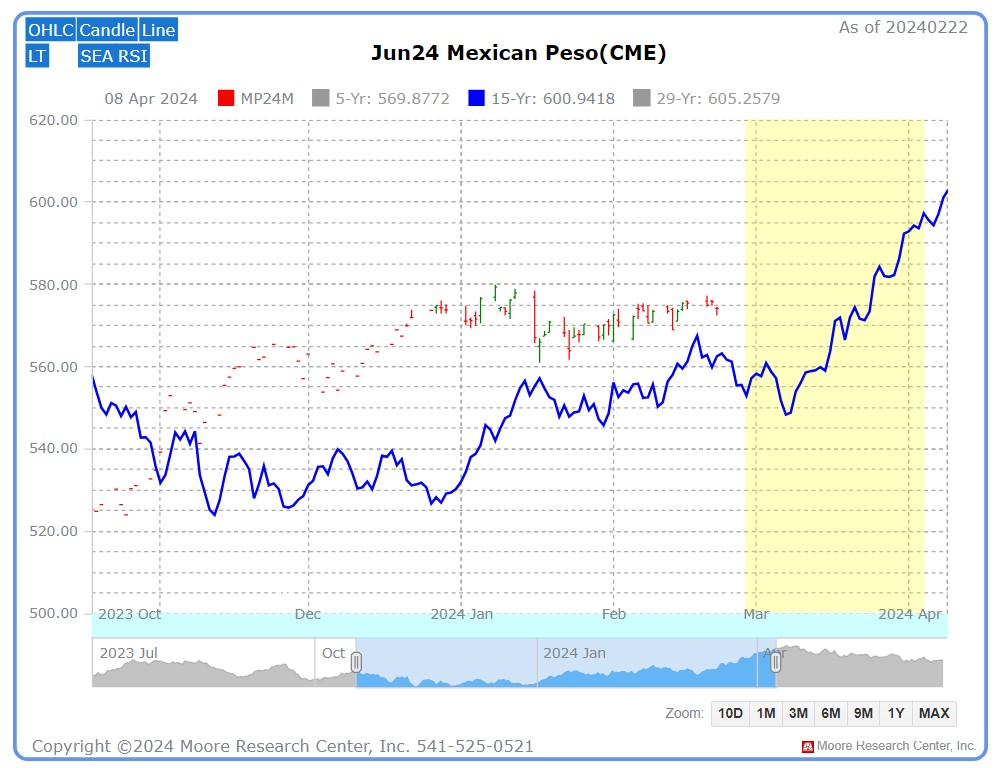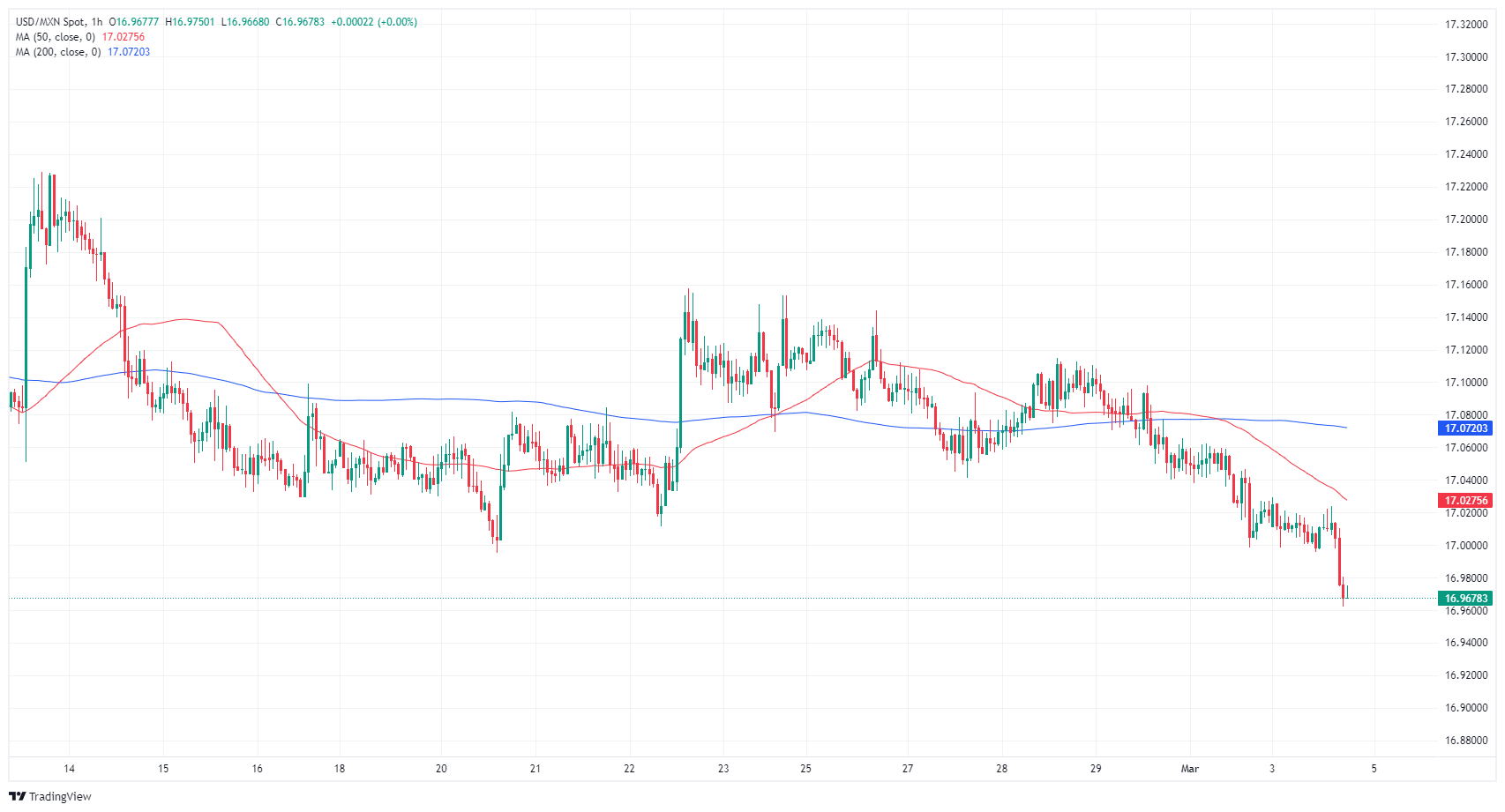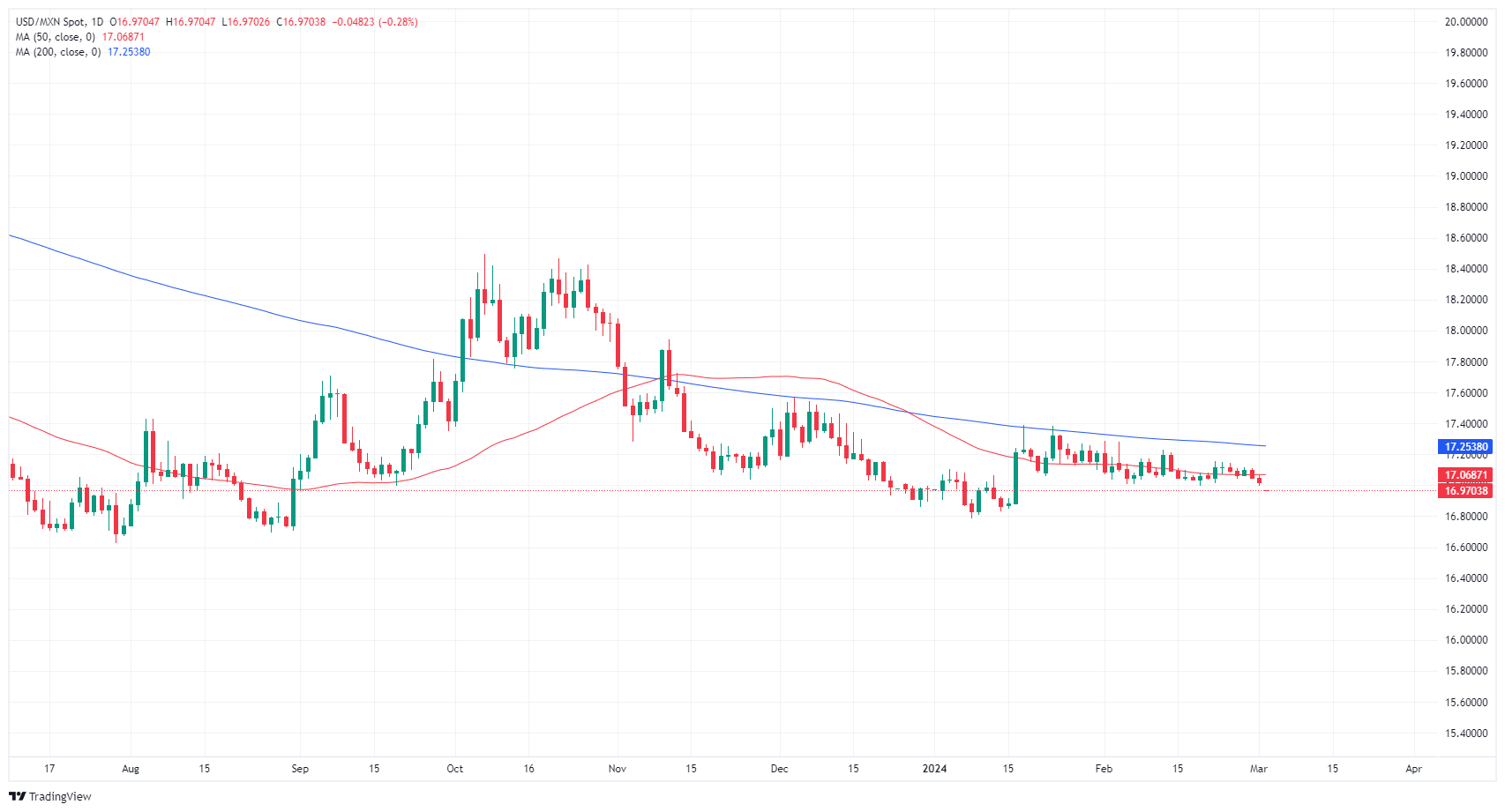- Analytics
- News and Tools
- Market News
- Mexican Peso breaks higher on Monday as rate cut bets mix with seasonal flows
Mexican Peso breaks higher on Monday as rate cut bets mix with seasonal flows
- The Mexican Peso found fresh gains against the US Dollar on Monday.
- Mexican inflation is expected to ease sharply, propping up Banxico cut expectations.
- Seasonal flows typically bolster the Mexican Peso at the tail end of the first quarter.
The Mexican Peso (MXN) gained ground against the US Dollar (USD) on Monday as counter-balanced rate cut expectations push the USD/MXN pair further down the charts. Common seasonal flows see bullish momentum leak into the Mexican Peso during the first quarter, and markets are forecasting a tumble in Mexican inflation.
Mexico is broadly expected to see further rate cuts from the Banco de México, aka Banxico. Mexico’s main reference rate has been held at record highs of 11.25% since April of 2023. US labor figures are also in the mix, with Friday’s Nonfarm Payrolls (NFP) in the barrel. Hopes of market rate cuts from the Federal Reserve (Fed) are also weighing on Monday market action.
Daily digest market movers: Uptick in Banxico rate cut bets push Peso to six-week highs
- Mexico’s inflation print due on Thursday is expected to print a continued decline in Mexican price growth, forecast to print at 0.12% for February versus the previous 0.89%.
- January’s 0.89% Mexico inflation print was a 22-month high.
- This week’s US labor figures kick off with Wednesday’s ADP Employment Change for February, forecast to jump to 150K from the previous 107K.
- Fed Chairman Jerome Powell due to testify before the Financial Services Committee about the Semi-Annual Monetary Policy Report on Wednesday and Thursday.
- Friday’s February US NFP is expected to fall back to 200K from the previous 353K, and investors will be keeping a close eye on revisions to previous prints.
- Tuesday will kick off the US weekly data docket with ISM Services Purchasing Managers Index (PMI) figures for February forecast to tick down to 53.0 from 53.4.
- The Mexican Peso typically finds bullish interest heading into the second quarter, according to the Moore Research Center (MRCI).
- MRCI: Mexican Peso has closed higher from February 28 to April 4 about 93% of the time over the past 15 years.

Technical analysis: USD/MXN drops into new lows as Peso finds bullish bids
The Mexican Peso (MXN) is climbing on Monday, driving the USD/MXN pair down below the 17.00 handle for the first time since mid-January. The pair is down nine-tenths of a percent from last week’s peak bids near 17.12.
USD/MXN is on pace to close in the red for a third consecutive trading day, and bids are tumbling into chart territory last seen in January. 2024’s technical floor sits at January’s swing low into the 16.80 handle, and the pair continues to drop away from the 200-day Simple Moving Average (SMA) at 17.25.
USD/MXN hourly chart
USD/MXN daily chart
Mexican Peso FAQs
What key factors drive the Mexican Peso?
The Mexican Peso (MXN) is the most traded currency among its Latin American peers. Its value is broadly determined by the performance of the Mexican economy, the country’s central bank’s policy, the amount of foreign investment in the country and even the levels of remittances sent by Mexicans who live abroad, particularly in the United States. Geopolitical trends can also move MXN: for example, the process of nearshoring – or the decision by some firms to relocate manufacturing capacity and supply chains closer to their home countries – is also seen as a catalyst for the Mexican currency as the country is considered a key manufacturing hub in the American continent. Another catalyst for MXN is Oil prices as Mexico is a key exporter of the commodity.
How do decisions of the Banxico impact the Mexican Peso?
The main objective of Mexico’s central bank, also known as Banxico, is to maintain inflation at low and stable levels (at or close to its target of 3%, the midpoint in a tolerance band of between 2% and 4%). To this end, the bank sets an appropriate level of interest rates. When inflation is too high, Banxico will attempt to tame it by raising interest rates, making it more expensive for households and businesses to borrow money, thus cooling demand and the overall economy. Higher interest rates are generally positive for the Mexican Peso (MXN) as they lead to higher yields, making the country a more attractive place for investors. On the contrary, lower interest rates tend to weaken MXN.
How does economic data influence the value of the Mexican Peso?
Macroeconomic data releases are key to assess the state of the economy and can have an impact on the Mexican Peso (MXN) valuation. A strong Mexican economy, based on high economic growth, low unemployment and high confidence is good for MXN. Not only does it attract more foreign investment but it may encourage the Bank of Mexico (Banxico) to increase interest rates, particularly if this strength comes together with elevated inflation. However, if economic data is weak, MXN is likely to depreciate.
How does broader risk sentiment impact the Mexican Peso?
As an emerging-market currency, the Mexican Peso (MXN) tends to strive during risk-on periods, or when investors perceive that broader market risks are low and thus are eager to engage with investments that carry a higher risk. Conversely, MXN tends to weaken at times of market turbulence or economic uncertainty as investors tend to sell higher-risk assets and flee to the more-stable safe havens.
© 2000-2024. All rights reserved.
This site is managed by Teletrade D.J. LLC 2351 LLC 2022 (Euro House, Richmond Hill Road, Kingstown, VC0100, St. Vincent and the Grenadines).
The information on this website is for informational purposes only and does not constitute any investment advice.
The company does not serve or provide services to customers who are residents of the US, Canada, Iran, The Democratic People's Republic of Korea, Yemen and FATF blacklisted countries.
Making transactions on financial markets with marginal financial instruments opens up wide possibilities and allows investors who are willing to take risks to earn high profits, carrying a potentially high risk of losses at the same time. Therefore you should responsibly approach the issue of choosing the appropriate investment strategy, taking the available resources into account, before starting trading.
Use of the information: full or partial use of materials from this website must always be referenced to TeleTrade as the source of information. Use of the materials on the Internet must be accompanied by a hyperlink to teletrade.org. Automatic import of materials and information from this website is prohibited.
Please contact our PR department if you have any questions or need assistance at pr@teletrade.global.















